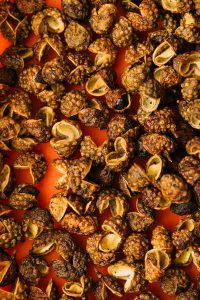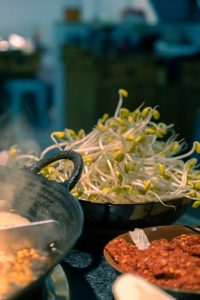Recently added items
Sichuan Peppercorns: Here’s everything you need to know about this Chinese spice
First of all, a chef’s kiss for every Sichuan dish.

Just a thought of it gets the mouth-watering.
If you’ve never tried Sichuan dishes, you’re in for a real treat.
Dishes with these little Sichuan peppercorns spices pack a big punch, and they’re perfect for adding a bit of heat to any dish. Just be warned – they can be quite addicting!
Now let’s talk about Sichuan Peppercorns, the hero of Sichuan sauce and dishes.
What is Sichuan peppercorn?

Sichuan peppercorn, also known as Szechuan peppercorns or Chinese pepper, is a member of the prickly ash family.
The dried fruit of the Sichuan pepper tree has a unique, peppery flavour that is used in cooking throughout Asia. Sichuan peppers are especially popular in Chinese cuisine, where they are used to add spice and heat to dishes.
They are also sometimes used to make a spicy oil called “la jiao yao”.
Origin and History
While the exact origins of the fruit are unknown, it is believed to have been first used in culinary applications over 2,000 years ago.
The “Shijing,” the “Classic of Poetry,” was written between the 11th and 7th centuries BC and contains the earliest mention of Sichuan peppercorns. Their use expressed affection.
In the Western Zhou Dynasty (1046-771 BC), it was common to utilise Sichuan peppercorns in rituals, exorcising evil spirits and incense. There’s a line in “Eulogies of Zhou” from “Shijing” that talks about how the scent of peppercorns promotes tranquillity and long life.
During the Zhou Dynasty, the people of the Chu State blended Sichuan peppercorns into wine to create jiaozi. The beverage was served during religious rites.
The Sanxingdui archeological site in Guanghan County, China, uncovered a vast number of copper-made yaoqianshu, or money trees, in 1986. The Sichuan peppercorn tree is said by some to be the ancestor of the money tree.
In the Western Han Dynasty (206 BC-AD 24), Weiyang Palace was the administrative hub and imperial home, and the empress lived in the Jiaofang Hall. The interior wall of the hall was painted with a concoction that included Sichuan peppercorns to discourage insects, hence the name “peppercorn hall,” or Jiaofang in Chinese.
Sichuan peppercorns were employed in ancient times to preserve corpses alongside other spices and herbs as a pesticide.
Chillies, a staple of Chinese cuisine, were not brought to China from South America until the end of the 16th century, despite the popularity of spicy food in China. For a long time, the sweet and salty seasonings were the mainstays of ancient Chinese cuisine.
In Chinese cuisine, xin and la allude to pungency and spiciness, respectively, and it is vital to distinguish between the two. Xin can be derived from ginger, garlic, scallion, and cornel, whereas elements like chillies and garlic contribute to the flavour profile.
In ancient times, people thought the numbness of the tongue after consuming Sichuan peppercorns to be a harmful reaction. There was no widespread use of Sichuan peppercorns until the Southern and Northern Dynasties (AD 420-589).
This peppercorn was used extensively in Chinese cuisine during the Tang Dynasty (AD 618-907), and it was also a tribute to the imperial court. People were addicted to the spice’s unique aroma and flavour.
More than 22% of Chinese recipes had Sichuan peppercorns before the arrival of chillies and over 40% during the Tang dynasty. [1]
Taste
Sichuan peppercorns come in two varieties: red peppercorns, which have a more earthy flavour, and green peppercorns, which have a more floral flavour.
A tingling feeling rather than heat sets Sichuan peppercorns apart from other peppercorn varieties.
The taste of Sichuan peppercorn is often described as being citrusy, with notes of lemon and orange. It also has a slightly woody taste and a mildly spicy kick. The fruit is used as a spice in many dishes, including stir-fries, soups, and marinades.
Harvest
These little rough fruits, which are only harvested once a year in the late summer, are painstakingly pulled from their thorny branches by hand and left out to dry naturally in the sun’s heat.
When the berries dry out, they open up into a characteristic floral shape, earning the spice the nickname Hua jiao, which translates as “flower pepper” in the Chinese language. The aromatic peppercorns are hand-processed to guarantee that no thorns, seeds, or twigs are introduced into the batch after the dried husks have been opened to release their tiny black seeds, which are bitter and inedible. It’s a time-consuming procedure, but it’s a labour of love on their part.
Sichuan Pepper Vs. Black Pepper
Sichuan pepper is sometimes confused with black pepper, but the two spices are quite different. Black pepper is made from the dried berries of the Piper nigrum plant, while Sichuan peppercorn comes from the dried berries of the Zanthoxylum bungeanum plant.
Both spices are commonly used in Chinese cuisine, but Sichuan peppercorn is more prevalent in dishes from the Sichuan province.
Uses
Except for the culinary uses, Sichuan peppercorns have been revered in China for more than two millennia because of their many other benefits.
Like the gong jiao tribute pepper, some peppers were previously picked only as fertility gifts for ancient emperors and their concubines because of their anti-inflammatory and analgesic properties.
Traditionally used in China, Zanthoxylum bungeanum is included in the Pharmacopoeia of the People’s Republic of China and prescribed for many diseases, including stomach pain, toothache and dermatitis.
Analgesic, anti-inflammatory, antibacterial, and antioxidant properties have been discovered in Z. bungeanum. Z. armature’s medical application in treating digestive, respiratory, and cardiovascular problems.
Cooking with Sichuan Peppercorns

There are various ways to utilise Sichuan peppercorns in cooking, but the most straightforward is to add them to sauces, soups, and other dishes.
Spiced boiled fish is served with peppercorns, dried chillies, and minced garlic sprinkled on the dish, splattered with hot sizzling oil.
Peppercorn oil is a condiment that gives the flavour of peppercorns without the use of dry spice. It goes well with cold salads and noodle dishes.
One of China’s most famous condiments is Jiaoyan or Sichuan peppercorn salt. To make it, salt and Sichuan pepper are heated in a wok until they begin to brown, then finely ground.
Jiaoyan in supermarkets comes in smaller sachets, but the aroma isn’t as intense.
Eating leaves from the Sichuan peppercorn tree gives pancakes or steamed buns an extra kick of flavour.
To produce a snack, some people deep-fry fresh peppercorn leaves coated in flour and egg before deep-frying.
Sichuan Peppercorns Substitute
You can use freshly ground black pepper and coriander seeds as Sichuan pepper substitutes if you don’t have them. If you have Tellicherry peppercorn on hand, you can use it as a replacement. As a result, the flavour and aroma of this type of black pepper are enhanced by a prolonged ripening period.
Where Can I buy Sichuan Peppercorns?
Sichuan peppercorns can be found in Asian groceries and specialty spice shops. Various names are used for marketing it, such as dehydrated pepper, floral pepper, Indonesian lemon pepper, and Hua jiao in Mandarin.
Global Peppercorns is the premier supplier of Sichuan peppercorns in Australia. We are a trader and manufacturer of peppercorns & peppercorn products and offer various grades and packaging options to suit your needs.
Our peppercorns are sourced from the finest growers in Sichuan province, and they are carefully cleaned and processed to ensure optimum quality know about Sichuan peppercorns, look no further than Global Peppercorns!
How to Store Sichuan Peppercorns?
If you want to store your Sichuan peppercorns, it’s best to keep them in an airtight container in a cool, dark place. This will help them stay fresh for longer. You can also freeze them if you want to store them for longer than a few months.
Giving your peppercorns a good sniff is a surefire way to tell if they’ve gone stale. They’re probably duds if you don’t get a whiff of citrusy aroma from them.
How To Roast Sichuan Peppercorns?
To roast Sichuan peppercorns, you will need:
-1/2 teaspoon Sichuan peppercorns
-1/4 teaspoon salt
-1 tablespoon vegetable oil
-1/4 cup water
Instructions:
- Preheat the oven to 375 degrees F (190 degrees C).
- Combine the Sichuan peppercorns, salt, vegetable oil, and water in a small bowl.
- Spread the mixture on a baking sheet.
- Bake for 15 minutes or until the peppercorns are roasted.
- Remove from the oven and let cool before using.
Final thought,
So there you have it – everything you need to know about Sichuan peppercorns.
Now that you understand their flavour and potential uses, why not order a bag and experiment for yourself? We think you’ll be pleasantly surprised by the unique taste they add to dishes, both savoury and sweet.
Reference:


